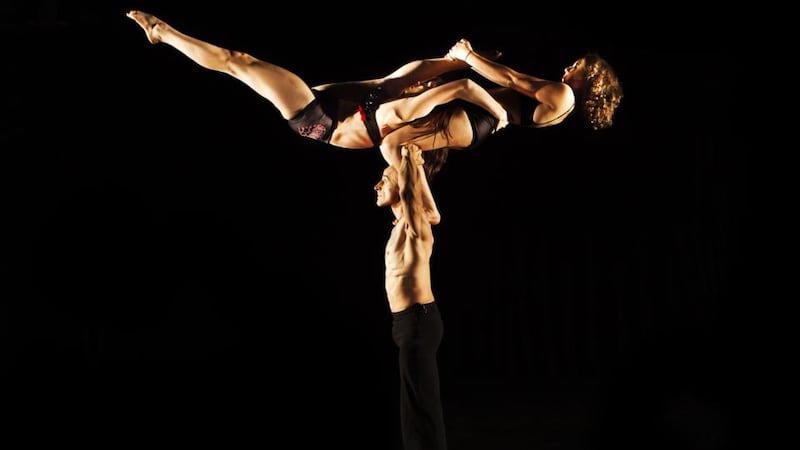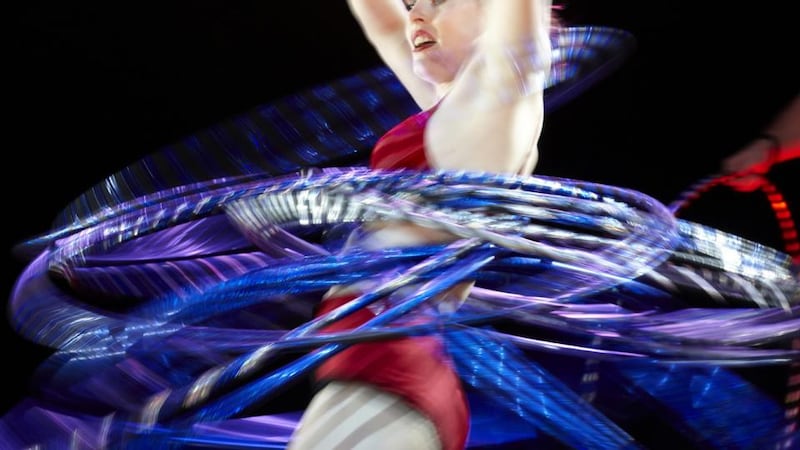They call the scene “Crack”. Given the back-breaking risks that the Australian contemporary circus company have put on display, this sounds painful.
The extraordinary acrobats of the Brisbane-based Circa build human towers, three or four people high, which topple and collapse. They breezily cup their hands as someone dashes towards them and the runner springs into a triple backwards somersault. Two powerfully built men swing the body of a woman like a hammock before sending her spinning horizontally through the air towards the shoulders of a petite woman who seems unprepared. (She isn’t.) Are there even names for such breathtaking feats?
The McEwan Hall in Edinburgh’s Bristo Square is a beautiful 19th-century rotunda belonging to Edinburgh University, with the awesome space and reverberations of a place of worship. During the Edinburgh Fringe, of course, it plays host to a temporary generic black-box space festooned with promotional emblems in the shape of a purple cartoon cow. Still, before another sold-out performance begins, it is an atmospheric place to see the Circa ensemble do their warm up. Silent and serious as monks (albeit with considerably less clothing), performers would then leap into a skill – a headstand, say, or a backwards roll from a standing position – and hit the floor, feet first, with a resounding thump.


To see them at rest, with bodies that recall the chiselled perfection of Greek statues more than Calvin Klein models, you might determine to get back to the gym. To see them in action, breaking the laws of physics and blowing your mind, you might roll your eyes and buy a tub of ice cream.
What's in a name?
"Crack," the tour manager smiles with slight apology, is just the name that suits the style of one scene and, besides, the music used – a key component to any Circa show – is a shuffling conspiracy of electronic and jazz patterns by Barry Adamson is called Crackula Has Risen From the Grave. Another scene, known to the troupe as Toss The Girl, needs less explanation, but a lot of insurance.
Otherwise, the names of individual skills can be universally understood (“Two-high” for someone standing on another person’s shoulders, “three-high” when you add another storey) or are utterly idiosyncratic. A death-defying feat might be named after the colour of a shirt it’s creator was wearing on the day; another might be christened The Eiffel Tower if someone made an architectural association.
Circa grew out of a Brisbane company called Rock N Roll Circus, when the theatre director Yaron Lifschitz tried to introduce character and story to its dazzle and display, then abandoned the idea.
“Fundamentally, theatre is based on tension and conflict,” Lifschitz told me a few years ago. “In circus, people never disagree with each other – otherwise you’d drop your partner. It’s better that we’re all listening to each other and working out where the genuine tension really is.”
It seems strange, though, that other ensembles under Circa’s umbrella (they have seven shows in repertory, touring the world) don’t even agree on the terms of performance among themselves: like Adam in Eden, everyone could create their own terms. Clear communication, though, seems essential when you’re six metres high on a Chinese pole, standing as perpendicular as a flag in a strong breeze and reaching out to catch your partner with your extended toes. Can it transcend language?
Watching such a sequence, between Lewis West and Todd Kirby, I find my own words shrinking in my notebook from a wan attempt to interpret the scene – wearing uniforms, the men might be soldiers, weary brothers in arms, executing manoeuvres of support and assistance, but it isn't too much of a stretch to think they could be lovers – and there's a scrawl of exclamation marks as I involuntarily gasp or whistle through my teeth.
There are no words.
Whuuughhh!
"I love that," says Lewis West (he pronounces it Louie). "You can feel when an audience is holding its breath with you. One of my favourite parts of performing is the involuntary noises. The gasps and laughs. Because people can clap if they want to, but when you hear someone go 'Whuuughhh!' or 'Oh my Gooood', you know they're right there with you. One of the reasons we don't have quite strict choreography is so we can react to that."
West, who has been with the company for five years, has a compact frame, a delicate face and blond curls like a Renaissance cherub. In performance, though, he can be as tender, suffering or as brutal as the scene requires. For one of the company's signature sequences, from the shows The Space Between and Circa, a woman in perilously high stilettos engages in a choreographed dance of trust and suspicion with her male partner – all aggressive throws and caring catches – which finally resolves in the man in a crab position and the woman walking slowly up his chest. West has not performed the scene in two years and the scars, he says, are only now beginning to heal.
West began as a gymnast, but grew tired of the solemnity and tedium of training, and moved to youth circus, and then to the National Institute of Circus Artists, where he studied for three years. “It’s so ridiculous,” he says, laughing and unrolling an invisible parchment. “Look, I’m qualified.”
There he learned about anatomy, physiology, injury prevention and recuperation, and business management. “But, like anything you do in the performing arts, you need to just go out and do it.”
Australia has become the world leader in contemporary circus, with companies such as Circa, Casus, La Cirque and AfterDark touring frequently, exhibiting inordinate levels of skill, humour, sex appeal and adventure. Chinese troupes and Russian troupes may be famed for precision and virtuosity, but they don’t travel with as much ease or demonstrate as much character. Remote enough to develop independently, but connected enough to take influences and run with them, companies in Australia may have been ideally situated to develop the art of circus.
'Weird thing going'
In 1982, the Nanjing Acrobatic Troupe of China came to Victoria and New South Wales, to work with the children's circus Flying Fruit Fly Circus, Circus Oz and others, with long-lasting effects. "So we do get that highly skilled background," says West, "and then we're kind of left a bit to our own devices to kind of ferment and be weird. I've seen a lot of the European circuses – and they're amazing – but they're all so close. Like, you can drive from one country to the next and have Italian jugglers training with French hand balancers and they borrow from each other. In Australia, we just kind of get that weird thing going. Hopefully it's fresh to overseas audiences."
Yaron Lifschitz even considers circus a frontier art form. “Circus is an incredible mélange of things that is only unified by one factor. You and I can’t do them. One of the reasons it’s such a frontier art form is that it’s incontrovertible. If you can hold three people on your shoulders or do a backwards somersault through the air, you don’t need any colonial power, teacher or parent to tell you that you’re any good. You just are. Deep in the complex psychology of the circus performer and the circus idiom, that brings its own legitimacy. As a tribe of very displaced people – sometimes from their society, sometimes from their family – that appeals to a frontier mentality.”
It also makes the narrative hard to confirm in an almost wordless spectacle, which short-circuits the intellect and hits straight at our capacity for delight, worry and wonder. West's ideas about certain scenes shift from night to night. "It's different in every show, but you find your journey and tell your own story. Sometimes it doesn't make sense." In the gasps and whuuughhhs and the oh my goooods of the performance, it doesn't have to.
Wunderkammer is at the Gaiety, Wednesday to Sunday; dublintheatrefestival.com

















